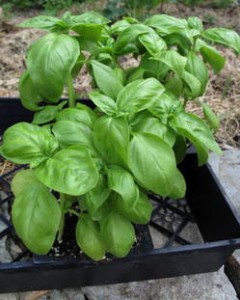One evening last week, between rain storms, Jim and I were motivated to head out of the house and into the garden for what started out as a 20 minute garden work session. Jim referred to this time of year in the garden as “the time of a thousand things to do.” Where do we even start? We could weed just about anywhere, transplant or divide what’s gotten too large, put seeds in the ground, get seedlings out of the cold frame and into the soil… The list goes on. How does a gardener make progress when, no matter what task she takes on, there’s still 999 more waiting?
It’s times like these that a person needs a strategy. Here are 3 tips for getting started when a start just doesn’t seem like enough.
1. Keep records.
A formal record like a gardening journal (or a blog!) can help a gardener stay organized and encouraged as well as providing reference information that will assist with planning in subsequent gardening seasons. Keeping track of the weather trends — is it always this rainy or does it just seem like it? — can also provide insight into why some plants thrive and others mope. Even jotting a few notes on the calendar about what was planted when can give a gardener a sense of time and progress. Taking digital photos of your garden as various stages is visual way of tracking progress; the date-stamp on the photo provides a handy reference point. Not much happens fast in a garden so one has to keep the long-term perspective in mind.
2. Have “Victory Conditions”.
We’ve used this phrase in our conversations for so long that I had to ask Jim if he remembered its origin– which he did. We adopted the concept of Victory conditions when our son was a teenager who played a lot of video games. Victory conditions are what counts as a “win” in a particular setting, be it staying alive, finding the prize, or winning a fight. The best video games, we were told, were the on-going ones with lots of levels, prizes, and bosses to defeat; a player couldn’t finish those in one sitting, so he would have to establish his own personal “victory conditions” of what would constitute an achievement for that session. Victory conditions are the goals that you aim for when the big goal (a lovely garden) cannot be achieved in just today.
When we go out in the garden, and especially during the time of a thousand things to do, we establish the day’s Victory Conditions. Although we do sometimes spend a few minutes here and there, but more often, we decide to focus on a manageable task that we finish or at least complete a step of. Recent tasks have included weeding and replanting in a section of a bed, preparing the soil and planting 8 cucumber plants, or thoroughly weeding along the stone edging of a raised bed. Setting victory conditions usually guarantees we will not get overwhelmed or discouraged, and when we are putting away the tools, we can see that we’ve accomplished some tangible task.
3. Keep doing something.
Last summer, Jim took a Motorcycle Maintanence course at WCC and gained a great deal of mechanical knowledge. He also picked up a little piece of philosophy that we’ve both found really helpful. One of his instructors advised: “Just keeping doing something and you’ll be the most productive worker in the shop.” Making the most of the time available to work is a good practice for a couple of reasons. There is always something to do in the garden, but there are also competing distractions. Although we all like to think we can multi-task, most things can be most effectively completed if we are only doing that one thing. So whatever amount of time you are able to carve out — and 20 minutes generally works for us–, give your time over fully to garden work.
The early months can seem especially busy for gardeners, even though our gardens keep us occupied all summer long. In our 20 minute garden, we’ve found that that keeping records, setting victory conditions, and a commitment to “keep doing something” help us stay inspired for the long haul and the rewards that come a little later in the season.



